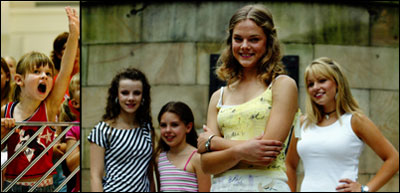|

No wonder young girls love horses: they're faithful, strong and dependable, says an academic expert. Matthew Thompson reports.
The allure of horses might now be drawing more tweenies than adolescents, but The Saddle Club's galloping business success on screen, page and stereo shows the big animals still have it, according to a children's literature specialist.
The Saddle Club is also a marketing love story, with Bonnie Bryant's books selling more than 500,000 copies in Australia; the ABC television series averaging almost the same number of viewers; video sales ranking in the top 20; three gold cast-member albums, and now Princess Veronica, a solo CD by Heli Simpson, who plays the show's rich bitch.
Simpson, 16, on the promotional hustings yesterday, reflected on horse appeal.
"People have been pondering that for a while.
"I think it's the way that a girl can have a relationship with a horse and have so much fun at the same time," she said.
Simpson, who has competed in equestrian events and is on her second horse, said that younger girls, in particular the tweenies and below, were increasingly drawn to The Saddle Club.
"Many of them are in love with horses, and anything with horse kind of themes is attractive to them," Simpson said.
Former president of the International Research Society for Children's Literature Professor John Stephens said yesterday that the "pony story" genre played to girls' desire for an "ideal companion".
"There are elements of romance... horses are faithful and strong; they need looking after but they look after you - it's what they're never going to get from men," said Stephens, Macquarie University's acting head of humanities.
Tales of girls and their horses, which began with Anna Sewell's 1877 novel Black Beauty, used to find an adolescent audience, but with the mysteries of life now revealed at ever younger ages, the market has changed, Stephens says.
"It was aimed at (ages) 11 to 14, but there's been a cultural shift in what they know, so it's probably aimed at pre-teens now," he said.
"But it's still the same genre, (and) it's like a love story: girl meets pony; girl gets pony; girl loses pony," he said.
The big beasts had also represented equality and empowerment after "women stopped riding side-saddle in about 1900 and started riding astride", Stephens said.
"That sort of changed the nature of how women related to a horse."
Women were not welcome participants in sports such as cricket, but riding astride enabled women to enter the equestrian world and compete in showjumping, Stephens said.
And as the genre grew with its audience, national differences developed.
"The US and Australia have wild horse stories - here it's the The Silver Brumby - but England doesn't have those stories so much," Stephens said.
Nevertheless, the appeal remained the same, and whether or not the lass and the horse stayed together in the end, "the girl really develops", he said.
|  |
|

